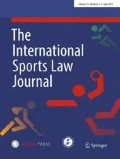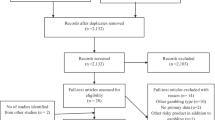Abstract
Formula-1 is considered one of the most dangerous, risky, and aggressive sports. As the legendary Brazilian Ayrton Senna stated, “there are no small accidents on this circuit”. It is a sport which by itself lies on the edge of continuous physical and mental human limits. Besides, it is (one of) the most expensive and globally commercialised human activities. With this in mind, it is relevant to ascertain how marginal practices, resembling manipulation of sports competitions, manifest themselves in that sport, and how the winning-at-all-cost strategy reveals itself. Accordingly, it is important to analyse how certain (usually commercially oriented) manipulative practices occur and, second, what should be done to identify such practices. Besides axiological issues, certain legal ambiguities are analysed in this article.
Similar content being viewed by others
Notes
In this article, manipulation of sport competitions, match-fixing and race-fixing are used in parallel, as synonyms.
151(c) provision stipulates that any fraudulent conduct or any act prejudicial to the interests of any competition or to the interests of motor sport generally is deemed to be a breach of rules.
The World Motor Sport Council decision passed in Monaco 6 December 2007. http://www.autosport.com/news/report.php/id/64309. Accessed 28 September 2016.
Explanatory Report to the Council of Europe Convention on the Manipulation of Sports Competitions (2014).
See more Zaksaite (2013), pp. 287–293.
Drivers must use the track at all times. For the avoidance of doubt, the white lines defining the track edges are considered to be part of the track but the kerbs are not. Should a car leave the track for any reason, and without prejudice to 2(d) below, the driver may rejoin. However, this may only be done when it is safe to do so and without gaining any advantage. A driver will be judged to have left the track if no part of the car remains in contact with the track.
3.2 Competitors must ensure that their cars comply with the conditions of eligibility and safety throughout practice and the race.
30.3 (a) During practice and the race, drivers may use only the track and must at all times observe the provisions of the Code relating to driving behaviour on circuits. (b) Other than by driving on the track, Competitors are not permitted to attempt to alter the grip of any part of the track surface.
39.1 Team orders which interfere with a race result are prohibited.
2009 International Sporting Code, http://www.jaf.or.jp/msports/rules/image/fiaMS_reg_e.pdf. 2009 FIA Sporting Regulations. http://argent.fia.com/web/fia-public.nsf/AAE9C10693C293F7C12575AF004512DC/$FILE/1-2009%20F1%20SPORTING%20REGULATIONS%20(Showing%20Alterations)%2024-03-2009.pdf. Accessed 28 September 2016.
The World Motor Sport Council decision passed in Paris on 21 September 2009. http://www.autosport.com/news/report.php/id/78771. Accessed 28 September 2016.
BBC Sport (2009).
Explanatory Report to the Council of Europe Convention on the Manipulation of Sports Competitions (2014), Art. 132, 134, pp. 21.
Ibid, Art. 151.
Zaksaite (2013), pp. 287–293.
English Bridge Union, White Book (2016).
A few athletes, including current 800 world record holder David Rudisha, have training partners who rabbit for them. McCallum (2011).
European Court of Justice, Cases C-72/10 and C-77/10, Marcello Costa, Ugo Cifone, 16 February 2012, Sect. 74.
Video material on youtube: Jean Todt – “Rubens let Michael pass for the championship”, https://www.youtube.com/watch?v=2yHPQSOziDw. Accessed 8 August 2016.
GPupdate (2008).
International Court of Appeal of the Federation Internationale De L'Automobile. Case Oberste Nationale Sportkommission für den Automobisport in Deutschland (ONS) for the driver Michael Schumacher, against the decision of the World Motor Sport Council of the Fédération Internationale de l’Automobile dated 26 July 1994, pp. 4–5. https://www.fia.com/file/55/download?token=TtHk8dpZ. Accessed 20 September 2016.
170. The drivers finishing the race in 1 st, 2nd and 3rd positions and a representative of the winning constructor must attend the prize-giving ceremony on the podium and abide by the podium procedure set out in Appendix 3 (except Monaco); and immediately thereafter make themselves available for a period of 90 min for the purpose of television unilateral interviews and the press conference in the media centre.
2010 F1 Sporting Regulations – published on 23.06.2010 (PDF) fia.com. 23.06.2010, pp. 24. Accessed 5 October 2015. 2010 International Sporting Code – published on 15.01.2010 (PDF) fia.com. 15.01.2010, pp. 19. Accessed 5 October 2015. 151. Breach of rules. c) Any fraudulent conduct or any act prejudicial to the interests of any competition or to the interests of motor sport generally.
Baldwin (2010). Accessed 5 August 2016.
World Chess Federation (FIDE), Laws of Chess: For competitions starting on or after 1 July 2014, http://www.fide.com/fide/handbook.html?id=171&view=article. Accessed 19 September 2016.
Badminton World Federation Disciplinary Committee reports, http://www.bwfbadminton.org/page.aspx?id=14883. Also Players’ Code of Conduct (updated 9 Nov 2015), 4.5 and 4.17 clauses, http://www.bwfbadminton.org/file.aspx?id=679517&dl=1. Accessed 18 September 2016.
Moul and Nye (2007), pp. 2, 24.
Collantine (2007). Accessed 5 August 2016.
Hynes (2015). Accessed 5 August 2016.
Barretto (2016).
Cooper (2014).
More on the principle of legality see, for example, Greer (2000).
François (1993). Ho Jeune Barreau de Liège, Liège, pp. 10 in Predescu I, Safta M. The Principle of legal certainty, basis for the rule of law landmark case-law. http://www.ccr.ro/ccrold/publications/buletin/8/predescuen.pdf. Accessed 17 September 2016.
Buonpane (2015). Accessed 5 August 2016.
Aprilia Racing S.R.L. Code of Ethics (2014). Accessed 5 August 2016.
2016 F1 Technical Regulations.
The Guardian (2010).
Carpenter (2013).
Formula One racing is constituted of dual components key to car racing: the competition between drivers and the competition between technologies. See more: Young (2012).
Quotes of Ayrton Senna: http://www.brainyquote.com/quotes/authors/a/ayrton_senna.html. Accessed 5 August 2016.
References
2002 F1 Sporting Regulations published on 14.12.2001 (PDF). Accessed 18 October 2016
2009 F1 Sporting Regulations published on 24.03.2009 (PDF). Accessed 28 September 2016
2009 FIA International Sporting Code published on 22.01.2009 (PDF). Accessed 28 September 2016
2010 F1 Sporting Regulations published on 23.06.2010 (PDF). Accessed 8 August 2016
2010 FIA International Sporting Code published on 15.01.2010 (PDF). Accessed 8 August 2016
2016 Appendix L of the International Sporting Code published on 28.06.2016 (PDF). Accessed 28 September 2016
2016 F1 Sporting Regulations published on 20.04.2016 (PDF). Accessed 5 August 2016
2016 F1 Technical Regulations published on 27.02.2016 (PDF). http://www.fia.com/regulation/category/110. Accessed 5 August 2016
Domestique. https://en.wikipedia.org/wiki/Domestique. Accessed 28 September 2016
Aprilia Racing S.R.L. Code of Ethics (October 2014). http://france.aprilia.com/fr/fr/index/tools/code-of-ethics-Aprilia-Racing.html. Accessed 8 August 2016
Badminton World Federation Disciplinary Committee reports. http://www.bwfbadminton.org/page.aspx?id=14883. Accessed 18 September 2016
Badminton World Federation Players’ Code of Conduct (updated 9 Nov 2015). http://www.bwfbadminton.org/file.aspx?id=679517&dl=1. Accessed 18 September 2016
Baldwin A (2010) Ferrari fined for German GP F1 result fix. http://www.stuff.co.nz/sport/motorsport/3957023/Ferrari-fined-for-German-GP-F1-result-fix. Accessed 8 August 2016
Barretto L (2016) “Juicy content” in F1 team radio won’t be lost with new rules—FIA. http://www.autosport.com/news/report.php/id/123316. Accessed 17 September 2016
BBC Sport (2009) Renault handed suspended F1 ban. http://news.bbc.co.uk/sport2/hi/motorsport/formula_one/8266090.stm. Accessed 17 October 2016
Buonpane V (2015) IndyCar, launched the new code of ethics. http://www.livegp.it/en/around-f1/83-motorsport-news/5005-indycar-launched-the-new-code-of-ethics.html. Accessed 8 August 2016
Carpenter K (2013) There’s no vettel in team: sporting match-fixing in F1? http://www.lawinsport.com/blog/kevin-carpenter/item/there-s-no-vettel-in-team-sporting-match-fixing-in-f1?highlight=WyJtYXRjaC1maXhpbmciLCInbWF0Y2gtZml4aW5nIiwibWF0Y2gtZml4aW5nJywiLCJtYXRjaC1maXhpbmcnIiwiJ21hdGNoLWZpeGluZycsIiwiJ21hdGNoLWZpeGluZyciLCJmMSIsImYxJ3MiLCInZjEiLCJmMScsIl0=. Accessed 8 August 2016
Collantine K (2007) Top ten… F1 scandals. http://www.f1fanatic.co.uk/2007/07/12/ten-of-the-best-f1-scandals/. Accessed 8 August 2016
Cooper A (2014) F1’s radio ban—full details of what is and isn’t allowed. https://adamcooperf1.com/2014/09/15/f1s-radio-ban-full-details-of-what-is-and-isnt-allowed/. Accessed 5 August 2016
Council of Europe Convention on the Manipulation of Sports Competitions. Magglingen/Macolin (2014), No. 215
English Bridge Union, White Book (2016) Law 72, 8.72.1 Actions to influence qualifying positions, http://www.ebu.co.uk/documents/laws-and-ethics/white-book/white-book-2016.pdf. Accessed 21 September 2016
European Court of Justice, Cases C-72/10 and C-77/10, Marcello Costa, Ugo Cifone, 16 February 2012, § 74
Explanatory Report to the Council of Europe Convention on the Manipulation of Sports Competitions (2014). https://rm.coe.int/CoERMPublicCommonSearchServices/DisplayDCTMContent?documentId=09000016800d383f. Accessed 28 September 2016
François L (1993) Le problème de la sécurité juridique, book La sécurité juridique. Publishing House Ho Jeune Barreau de Liège, Liège
GPupdate (2008) Barrichello admits Ferrari team orders. http://www.gpupdate.net/en/f1-news/203773/barrichello-admits-ferrari-team-orders/. Accessed 5 August 2016
Greer S (2000) Human rights files No. 17. The Margin of Appreciation: Interpretation and Discretion under the European Convention on Human Rights. http://www.echr.coe.int/LibraryDocs/DG2/HRFILES/DG2-EN-HRFILES-17%282000%29.pdf. Accessed 18 September 2016
Hynes J (2015) F1 Driver coaching via radio—what is and is not allowed in 2015. http://www.jamesallenonf1.com/2015/02/f1-driver-coaching-via-radio-what-is-and-is-not-allowed-in-2015. Accessed 8 August 2016
International Court of Appeal of the Federation Internationale De L’Automobile. Case Oberste Nationale Sportkommission für den Automobisport in Deutschland (ONS) for the driver Michael Schumacher, against the decision of the World Motor Sport Council of the Fédération Internationale de l’Automobile dated 26 July 1994. https://www.fia.com/file/55/download?token=TtHk8dpZ. Accessed 20 September 2016
McCallum J (2011) Run Rabbit Run (Then Get Out of the Way). http://www.runnersworld.com/elite-runners/pace-setters-for-elite-runners. Accessed 11 October 2016
Medland C (2016) FIA clarifies permitted driver messages. http://en.f1i.com/news/64552-fia-clarifies-permitted-driver-messages.html. Accessed 8 August 2016
Moul CC, Nye JVC (2007) Did the soviets collude? A statistical analysis of championship chess 1940-64. Washington University, St. Louis Winter
Noble J (2016) Analysis: The full scope of F1’s 2016 radio ban. http://www.motorsport.com/f1/news/analysis-the-full-scope-of-f1-s-2016-radio-ban-677934/. Accessed 8 August 2016
Predescu I, Safta M The Principle of legal certainty, basis for the rule of law landmark case-law. http://www.ccr.ro/ccrold/publications/buletin/8/predescuen.pdf Accessed 17 September 2016
Quotes of Ayrton Sena: http://www.brainyquote.com/quotes/authors/a/ayrton_senna.html. Accessed 5 August 2016
Recommendation CM/Rec(2010)9 of the Committee of Ministers to member states on the revised Code of Sports Ethics. Adopted on 16 June 2010
Standen J (2009) The manly sports: the problematic use of criminal law to regulate sports violence. J Criminal Law Criminol 99(3). http://scholarlycommons.law.northwestern.edu/cgi/viewcontent.cgi?article=7329&context=jclc
The Guardian (2010) FIA removes ban on team orders from Formula One regulations. http://www.theguardian.com/sport/2010/dec/10/fia-removes-f1-team-orders-ban. Accessed 8 August 2016
The World Motor Sport Council decision passed in Monaco 6 December 2007. http://www.autosport.com/news/report.php/id/64309. Accessed 28 September 2016
The World Motor Sport Council decision passed in Paris on 21 September 2009. http://www.autosport.com/news/report.php/id/78771. Accessed 28 September 2016
Video material on youtube: Jean Todt—“Rubens let Michael pass for the championship”, https://www.youtube.com/watch?v=2yHPQSOziDw. Accessed 8 August 2016
World Chess Federation (FIDE), Laws of Chess. http://www.fide.com/fide/handbook.html?id=171&view=article. Accessed 19 September 2016
Young S (2012) Formula One Racing: Driver vs. Technology. Intersect Stanf J Sci Technol Soc 5. http://ojs.stanford.edu/ojs/index.php/intersect/article/view/349
Zaksaite S (2013) Match-fixing: the shifting interplay between tactics, disciplinary offence and crime. Int Sports Law J 13(3):287–293
Žalnieriūnas L, Gutauskas A (2014) Fizinio smurto sporte baudžiamasis teisinis įvertinimas (Eng. Criminal liability for violence in sports). JURISPRUDENCE 21(3):885–906
Author information
Authors and Affiliations
Corresponding author
Rights and permissions
About this article
Cite this article
Zaksaitė, S., Raduševičius, K. Manipulation of competitions in Formula-1: where policy ends and cheating begins. Int Sports Law J 16, 240–246 (2017). https://doi.org/10.1007/s40318-016-0104-1
Published:
Issue Date:
DOI: https://doi.org/10.1007/s40318-016-0104-1



